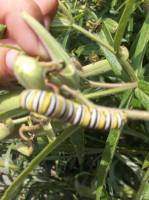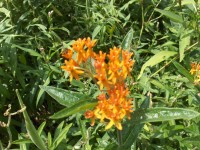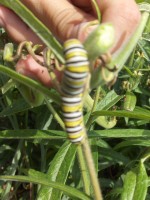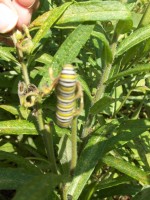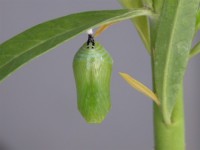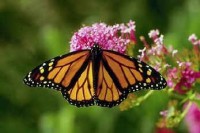As August continues to fly by, my time here at Shaver’s Creek is coming to an end. It has been an action packed summer full of exploring, summer camps, singing, and campfires… I would go as far as saying this is probably the best summer ever. As I look forward to moving to Maryland for grad school, I can’t help but think of another creature that is about to embark on a 2000 mile journey to Mexico. Any guesses on what this creature is?
If you guessed the Monarch butterfly then you are correct! Monarchs are one of the most cherished and widely recognized butterflies in Pennsylvania. The scientific name of the Monarch is Danaus plexippu which in Greek literally means “sleepy transformation.” According to the World Wildlife Fund, “The name, which evokes the species’ ability to hibernate and metamorphize, is actually inspired by the Greek myth of Danaus, in which the daughters of Danaus, king of Libya, flee Libya for Greece in order to avoid marrying their cousins. The long, migratory journey of the Monarch butterflies is reminiscent of the daughters’ flight.” (www.worldwildlife.org)
Here at Shaver’s Creek we attract these Monarchs by planting both Common and Butterfly Milkweed (see image 2). The Monarchs lay their egg on milkweed, and the life cycle is set in motion! Soon the egg will hatch, and the caterpillar stage begins. Milkweed, which can be poisonous to other animals, is the only food that Monarch caterpillars eat. The poison that accumulates in the body of these caterpillars and later in butterflies provide a natural defense against predators that may try to eat them. After about two weeks, the caterpillar is now 2 inches in length and more than 2,700 times its original weight!
In its next stage the caterpillar will find a branch or twig, hang straight up and down and prepare for its last molt. The skin of the caterpillar splits, and the bright bands of yellow and black dissolve into a green sheath called a chrysalis (image 5). Inside this chrysalis (or ‘pupa’) a magical transformation occurs… the metamorphosis from caterpillar into butterfly. After about 15 days, the butterfly silently emerges and soon lifts into gentle fluttering flight.
The Monarchs that are currently emerging here at the Creek are called migrant butterflies. They will live for several months, unlike the Monarchs from early summer and spring who live only four or five weeks. Very soon, these Monarchs will take a two-thousand mile journey to Mexico to seek out warmer weather and food. How these delicate butterflies make this journey is still a mystery to scientists.
In late February these butterflies will mate, and begin their journey north. The female, now laden with eggs, will make it to the nearest milkweed field, lay her eggs and die. The cycle then begins again, and the emerging Monarch will continue its mother’s journey. This first generation will make it to the southern Gulf States in late April, mate, lay eggs, and die and so the cycle continues. By June, the second generation of butterflies will make it back here to Shaver’s Creek. Some will fly farther north to reach the Great Lakes and New England, while others will stay here to continue their magical life cycle.
As I begin my drive to Maryland tonight, I will look to these Monarchs for strength, because I know that they are not fearful of their journey and neither am I.
So good luck to the Monarchs, I will enjoy seeing their great-great-grandbutterflies here next summer.
– Luna, 2010 Summer Intern
**Images 5&6 can be found at http://www.kidzone.ws/animals/monarch_butterfly.htm **

